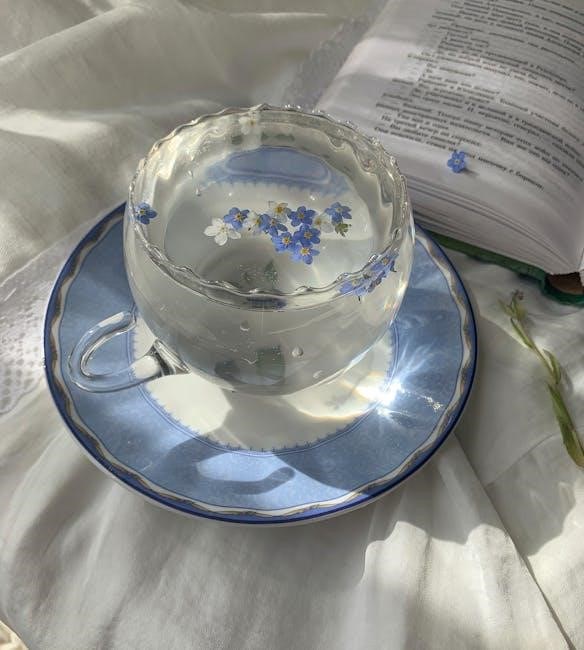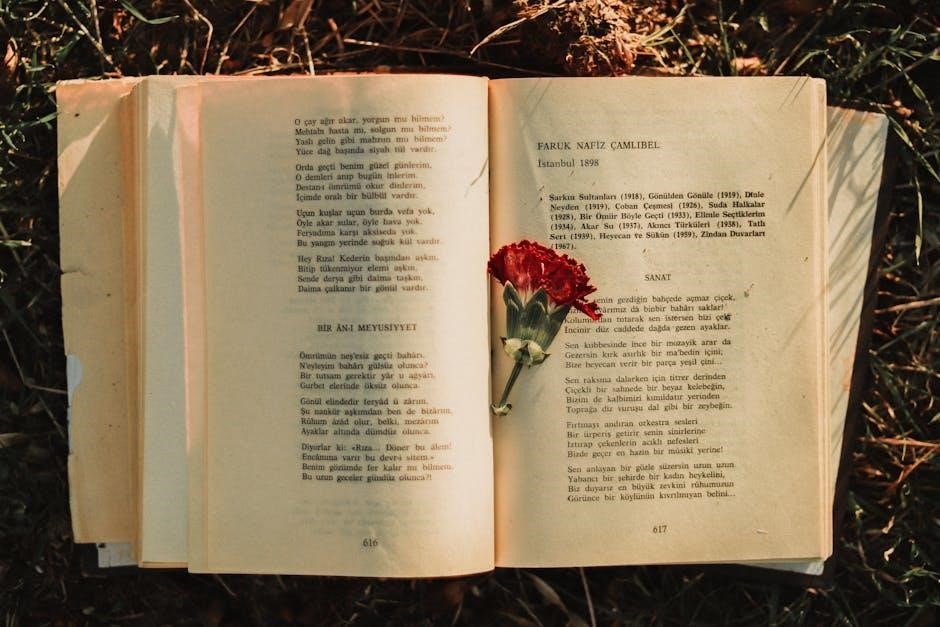Approach a poem PDF methodically to uncover its essence. Focus on themes‚ structure‚ and devices. Close reading enhances comprehension of the poet’s intent and emotional depth.
Understanding the Importance of Close Reading
Close reading is a foundational skill for analyzing poetry‚ enabling readers to uncover layers of meaning beyond the surface. It involves a meticulous examination of language‚ structure‚ and literary devices. By focusing on details like word choice‚ imagery‚ and rhythm‚ readers can gain deeper insights into the poet’s intent. This method helps identify themes‚ symbols‚ and underlying messages that might otherwise go unnoticed. Close reading also fosters a richer understanding of the poem’s emotional and cultural impact. It requires patience and multiple readings‚ as rushing through the text can lead to missed interpretations. Mastering this approach enriches the reading experience and enhances analytical skills. Close reading is essential for both casual readers and scholars‚ making it a cornerstone of poetry analysis.
Essential Skills for Analyzing Poetry
Analyzing poetry effectively requires a combination of critical thinking and specific skills. First‚ identify the poem’s themes by pinpointing repeated ideas or emotions. Next‚ understand literary devices like metaphor‚ simile‚ and imagery‚ which convey deeper meanings. Recognizing poetic forms such as sonnets or free verse can provide context about the poet’s intentions. Interpreting symbols and allusions is also crucial‚ as they often carry layered significance. Additionally‚ consider the poet’s background and historical context to enrich your analysis. Developing these skills enhances your ability to engage deeply with poetry‚ revealing its complexity and beauty. Regular practice and exposure to various poetic styles will refine your analytical abilities‚ making you a more insightful reader.

Preparing to Read the Poem
Preparation is key to understanding a poem. Start by reading the title‚ skimming for themes‚ and researching the poet’s background to enhance your comprehension and appreciation.

Reading the Title and Initial Impressions
Begin by carefully reading the poem’s title‚ as it often provides a clue to the themes or subject matter. Take note of your initial impressions and any questions that arise. This step sets the stage for deeper analysis. Pay attention to the title’s imagery or symbolism‚ which can hint at the poem’s core ideas. For example‚ a title like “The Journey” might suggest themes of travel or self-discovery. Your first impressions are valuable‚ as they can guide your interpretation. Jot down any reactions or associations you have with the title before diving into the text. This practice helps you stay connected to your initial thoughts while exploring the poem’s layers.
Skimming the Poem for Key Themes
Before diving into a detailed analysis‚ skim the poem to identify its central themes and ideas. This step helps you grasp the overall message and emotional tone. Look for repeated words‚ phrases‚ or imagery that stand out‚ as these often highlight key themes. Pay attention to the poem’s structure and how it contributes to the unfolding ideas. For example‚ nature imagery might suggest themes of growth or decay‚ while abstract concepts could indicate philosophical reflections. Highlighting or underlining significant lines during this process can help you isolate themes and trace their development. This approach ensures you understand the poem’s core ideas before exploring its intricate details. Skimming also helps you connect the poet’s message to universal themes‚ making the poem more relatable and impactful.
Researching the Poet and Historical Context
Researching the poet and historical context is crucial for a deeper understanding of the poem. Knowing the poet’s background provides insight into their perspectives and influences‚ which shape the poem’s themes and tone. For instance‚ understanding the era in which the poet lived can reveal societal norms‚ political events‚ or cultural movements that influenced their work. Historical context helps decode references‚ allusions‚ or symbols that may not be immediately clear. Additionally‚ familiarizing yourself with the poet’s other works or biographical details can offer a broader understanding of their style and recurring motifs. This step enriches your interpretation by connecting the poem to its time and place‚ making it easier to identify underlying messages or hidden meanings. It also enhances your appreciation of the poet’s craft and intent. Researching context ensures a more informed and nuanced analysis. This foundational knowledge bridges the gap between the poem and its audience.

Understanding the Structure of the Poem
Analyzing a poem’s structure involves identifying form‚ stanzas‚ line breaks‚ meter‚ and rhythm. These elements guide the flow and emphasize themes‚ enhancing the reader’s interpretative experience.

Identifying the Poetic Form and Style
Recognizing poetic forms like sonnets‚ ballads‚ or free verse provides context. Each form has distinct characteristics‚ influencing how themes are conveyed. Style elements‚ such as language and syntax‚ reveal the poet’s voice and intent‚ while also reflecting the era or cultural background. Identifying these aspects helps in understanding the poem’s structure and the techniques used to communicate its message. By familiarizing yourself with common forms and styles‚ you can better appreciate the poet’s choices and how they contribute to the overall impact of the poem. This step is crucial for a deeper analysis and interpretation of the text.
Analyzing the Use of Stanzas and Line Breaks
The arrangement of stanzas and line breaks significantly impacts the rhythm and flow of a poem. Stanzas act as visual groupings of lines‚ often linking related ideas or emotions. Line breaks‚ or end stops‚ determine where lines pause or conclude‚ influencing the pacing and emphasis. Pay attention to how these breaks create suspense‚ highlight specific words‚ or alter the rhythm. White space between stanzas can symbolize transitions in thought or tone. Analyzing these structural elements helps uncover the poet’s intentional design and how it enhances the poem’s meaning. By examining stanzas and line breaks‚ you gain insights into the poem’s emotional cadence and the ways it guides the reader’s interpretation. This step is essential for understanding the interplay between form and content in poetry.
Exploring the Role of Meter and Rhythm
Meter and rhythm are fundamental elements in poetry‚ creating its musicality and emotional impact. Meter refers to the pattern of stressed and unstressed syllables in lines‚ often measured in feet. Common meters include iambic‚ trochaic‚ and dactylic‚ each producing a distinct rhythm. Rhythm‚ broader than meter‚ encompasses the overall flow and cadence of the poem‚ shaped by line breaks‚ pauses‚ and word choice. These elements guide the reader’s pacing‚ emphasizing certain words or ideas. Variations in rhythm can signal shifts in tone or mood‚ while a consistent meter may create a sense of stability; Recognizing these patterns enhances understanding of the poem’s structure and the poet’s intent‚ revealing how sound and sense intertwine to convey meaning and evoke emotion. Analyzing meter and rhythm deepens your connection to the poem’s artistic and emotional dimensions.

Delving into the Content of the Poem
Analyze themes‚ underlying messages‚ and literary devices to uncover the poet’s intent. Examine imagery‚ symbols‚ and metaphors to interpret deeper meanings and emotional resonance in the text.
Uncovering Themes and Underlying Messages
Identifying themes is crucial for understanding the poem’s core ideas. Themes often emerge through repetition of imagery‚ motifs‚ or emotional tones. Pay attention to recurring elements like love‚ nature‚ or freedom‚ as these may signify deeper messages. Underlying messages‚ or subtext‚ are ideas implied but not explicitly stated. These can be uncovered by analyzing the poet’s word choice‚ tone‚ and the speaker’s perspective. For example‚ a poem about a journey might symbolize personal growth or existential questioning. Consider the historical and cultural context to interpret subtle layers of meaning. Themes and messages may evolve as you delve deeper‚ revealing the poet’s intent and emotional resonance. This step requires careful observation and reflection to connect surface-level details with profound insights.

Examining Literary Devices and Imagery

Literary devices are essential tools poets use to convey meaning and emotion. Common devices include metaphors‚ similes‚ personification‚ alliteration‚ and symbolism. Each device adds depth and complexity to the poem. Imagery‚ a vivid description of people‚ places‚ or things‚ evokes sensory experiences‚ drawing the reader into the poem’s world. For example‚ visual imagery paints pictures‚ while auditory imagery captures sounds. Analyze how these elements reinforce the poem’s themes and tone. Pay attention to repeated motifs‚ as they often highlight central ideas. By identifying and interpreting these devices‚ you can uncover the poet’s intent and the emotional resonance of the work. This step requires a keen eye for detail and an understanding of how language creates powerful effects‚ enriching your overall interpretation of the poem.
Interpreting Symbolism and Metaphors
Symbols and metaphors are powerful tools in poetry‚ often carrying deeper meanings beyond their literal interpretation. Symbols represent ideas‚ objects‚ or relationships‚ while metaphors create vivid comparisons to evoke emotions or concepts. When analyzing a poem‚ identify recurring symbols and consider their cultural or personal significance to the poet. Metaphors‚ on the other hand‚ require unpacking the connection between the compared elements to reveal hidden truths or emotions. For example‚ a rose might symbolize love‚ while comparing life to a journey metaphorically highlights its twists and turns. These devices add layers of meaning‚ inviting readers to engage deeply with the poem. Pay attention to how symbols and metaphors interact with other elements like imagery or tone to enrich the poem’s message and emotional impact.

Interpreting the Poem’s Language and Tone
Word choice and tone reveal the poet’s attitude and emotional intent. Analyze diction‚ syntax‚ and figurative language to grasp the mood and the speaker’s perspective in the poem.
Understanding the Significance of Word Choice
Word choice in poetry is deliberate‚ carrying unique connotations and emotional weight. Each word contributes to the overall tone‚ theme‚ and mood‚ shaping the reader’s interpretation. Poets often select specific words to evoke precise imagery or convey subtle ideas. For instance‚ a word like “whisper” creates a softer‚ more intimate tone compared to “shout.” The diction‚ whether formal or informal‚ archaic or modern‚ reflects the poet’s intent and cultural context. Paying attention to repetition‚ alliteration‚ or unusual vocabulary can reveal deeper layers of meaning. Word choice also influences the poem’s rhythm and pacing‚ enhancing its musicality. By analyzing these linguistic elements‚ readers gain insight into the poet’s message and the emotional resonance of the work.
Recognizing the Speaker’s Voice and Perspective

Identifying the speaker’s voice and perspective is crucial for interpreting a poem. The speaker may not be the poet themselves but a created persona. Analyze pronouns like “I‚” “you‚” or “we” to determine who is narrating. The tone‚ language‚ and diction reveal the speaker’s attitude and background. Consider whether the voice is direct or indirect‚ and if it shifts throughout the poem. The speaker’s perspective may be influenced by their experiences‚ beliefs‚ or emotions‚ which are often implied through imagery and word choice. Understanding the speaker’s identity helps connect their viewpoint to the poem’s themes and messages‚ enriching your analysis and ensuring a deeper engagement with the text. Recognizing these elements bridges the gap between the reader and the poet’s intended communication.
Assessing the Emotional and Cultural Impact
Evaluating the emotional and cultural impact of a poem involves understanding how it resonates with readers and reflects societal norms. The emotional impact is shaped by the poet’s use of language‚ imagery‚ and tone‚ which evoke feelings such as joy‚ sorrow‚ or nostalgia. Cultural impact‚ on the other hand‚ is revealed through references to historical events‚ traditions‚ or social issues. Consider how the poem aligns with or challenges cultural values‚ and how it might be perceived by different audiences. The poet’s background and the time period in which the poem was written can also influence its cultural significance. By analyzing these elements‚ you can appreciate the poem’s ability to connect with readers on a deeper level and contribute to broader cultural conversations. This step enriches your understanding of the poem’s relevance and its power to inspire or provoke thought.
Mastering how to read a poem PDF is a rewarding journey. By understanding themes‚ structure‚ and language‚ you’ll uncover deeper meanings‚ enriching your appreciation of poetry.
Summarizing Your Analysis and Reflection
To conclude‚ summarizing your analysis and reflection is crucial for synthesizing insights. Start by restating the poem’s central themes and the poet’s intent. Highlight key literary devices like metaphors‚ imagery‚ and symbolism that contribute to the overall message. Reflect on how these elements evoke emotions or convey cultural nuances. Consider the historical context and the poet’s background‚ as these factors often shape the poem’s meaning; Finally‚ express your personal response‚ whether it aligns with or challenges the poet’s perspective. This process not only solidifies your understanding but also enhances your ability to articulate your thoughts effectively. Remember‚ a concise summary captures the essence without overwhelming details‚ making it accessible to others.